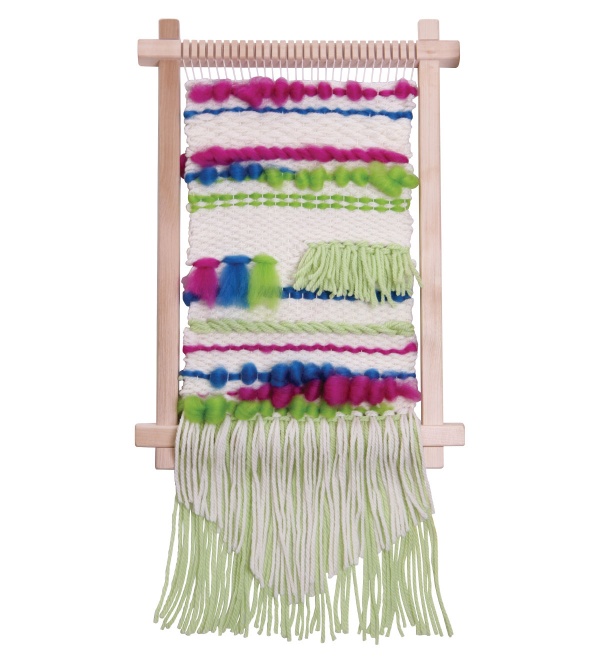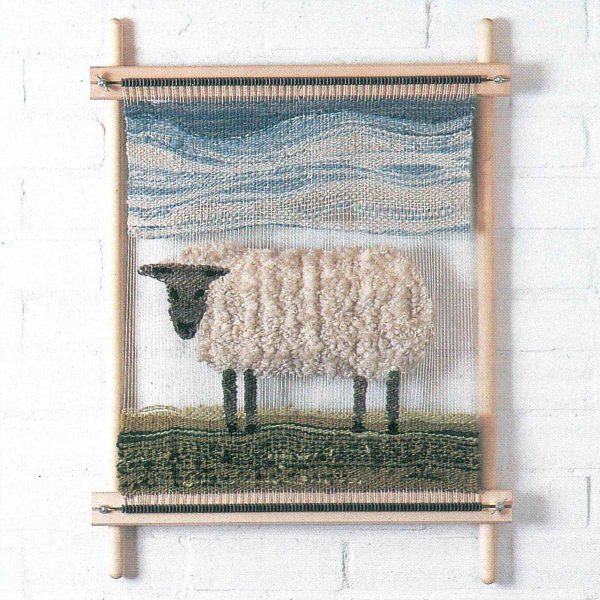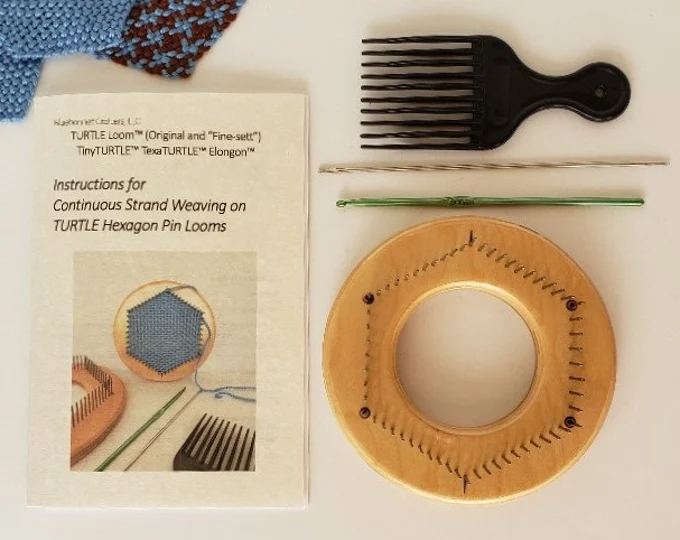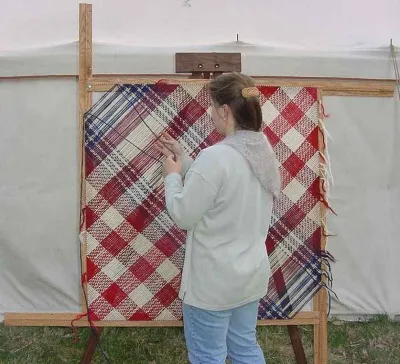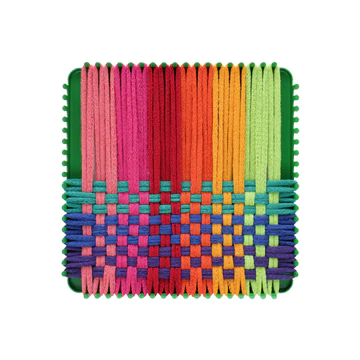Loom Spotlight: Frame Looms
equipmentFrame looms are a simple style of loom that consist of a fixed size frame, or, more rarely, a frame that can be put together in multiple sizes or pegs that can be rearranged on a board. I am not including here any sort of loom with features like the ability to roll up a warp and adjust tension and sett, such as more sophisticated tapestry looms. These looms have no built in shed making device; commercial kits may come with a weaving needle, or a shuttle and a pick up stick.
A frame loom can be as simple as a piece of cardboard or a photo frame that you wrap the warp around, with controlling the warp spacing up to the weaver, but most commercial frame looms have pegs or notches to help control the warp spacing. Frame looms are fairly simple to make.
Frame looms range from very small looms that are about as portable as knitting, to very large, long and wide but flat, looms. These looms may have notches or pegs along the top and bottom, or, around all sides, and this leads to different styles of weaving, so I'll split it up into two sections when discussing different types of frame looms.
Since these looms are a fixed size, they will generally be used for projects of a similar shape - you can make a narrower piece, and making a shorter piece will use some excess warp over a longer one.
Tapestry Style Looms #
This kind of loom wraps a warp around in one direction prior to weaving, as is the case with most other loom designs. While most are shaped more or less like an open rectangle, some smaller looms of this type are shaped like an uppercase I, which can be easier to hold on to. Simple frame looms are most often used for tapestry style weaving, but not all tapestry looms are simple frame looms.
These looms are mostly small lap looms, starting at less than 10"x10", but very large looms of this style exist up to ones traditionally used for making rag rugs. Larger looms may come with a stand or have one available. Particularly at larger sizes it may be difficult to keep even tension on a frame loom.
Typically this style of loom has pegs or notches that control and limit the warp spacing, though it is possible to make a DIY loom out of cardboard or a photo frame with no notches, which then makes it more difficult to have an even sett. Looms of this type often come with a pick up stick to make one shed while the weaver controls the other shed, but can also be used with just a tapestry needle.
Most looms of this type are designed around making weft faced tapestries, with fairly wide spacing for the teeth, and teeth that may be designed for fairly fine tapestry warp yarn with a wide sett. Thicker yarns to make a more balanced plain weave fabric might not fit depending on the design. The sett controls how finely detailed a tapestry work can be, and also drives which yarn combinations are suitable. Setts are commonly between 4 and 12 per inch; a 12 DPI frame loom may be more flexible as you could easily warp it as 4 or 6 as well by using every 2nd or 3rd notch.
In addition to being made by many weaving companies, this style of loom is also produced by some toy makers. For example, Melissa & Doug produces a fairly large, inexpensive loom that stands up.
Swatch Making Looms #
There are some looms that are similar to tapestry style frame looms but designed for making small swatches for other weaving, like Liz Gipson's Swatch Maker line which is designed for swatching for rigid heddle weavers at setts of 8-12 DPI, either on separate looms, or one loom which can handle all three setts by warping through holes, which is a bit trickier. These tend to be quite small as the purpose is to test out color combinations or sett with a small swatch in preparation for a bigger project.
Circular Looms #
Circular looms are most often used to make chunky abstract wall hangings. Not to be confused with a circular knitting loom, which has prominent pegs, they can be made of materials like wood, bamboo, or acrylic and typically have some sort of notch around the edges to help with warp spacing; some people also use embroidery hoops. Often the loom becomes the mounting for the finished piece. The warp spacing near the center will be much tighter than near the edges, particularly on larger looms, which will affect the texture of the fabric - these are most often used for making textured wall hangings than a "practical" fabric. These range from tiny 1" looms to about 18" or so.
Continuous Strand Looms #
Continuous strand looms have pegs all around the outside and can be woven using one continuous piece of yarn for warp and weft, so there's no distinction between warping and weaving. Looms of this type can be many shapes to enable weaving things that aren't rectangles, and the continuous strand technique produces a finished edge on all sides of the piece, making these ideal for constructing larger projects out of multiple pieces, or large triangular shawl with almost no wasted yarn. While these looms allow for weaving with one strand, other techniques are also possible. These looms are typically woven on using a needle and don't have any shed help, making the weaving a slower process.
Pin Looms #
Pin looms are a small, portable form of weaving, that became popular in the 1930's with the 4" square Weave-It loom, but some make pieces as small as 1". Projects are made up out of a series of small shapes (squares, hexagons, triangles, etc.) which are then joined together to make a larger piece. Pin loom squares can be made out of a single piece of yarn, and are a great "on the go" option that's about as portable as knitting. eLoomaNation has lots of information about pin looms. I particularly enjoy the possibilities of non-square pin looms to produce shapes that aren't rectangles!
Larger Continuous Strand Looms #
There doesn't seem to be a firm cutoff, but somewhere between 6-12" makers stop referring to their looms as pin looms. From there, these looms are often quite large, designed to make something like an entire triangular shawl at once, though on the edge are things like 12" square "dishcloth looms". They also exist as shaped pieces to weave garment panels on without further shaping, like this Vest Kit. Large rectangular continuous strand looms exist, and can enable weaving a rectangular shape on the bias, for example, to make a diagonal plaid. These looms are often DIY projects or made by smaller makers, like Hill Creek Yarn, who sell both fixed sized and adjustable looms.
Potholder Looms #
Potholder looms are fixed size squares with pegs on both sides which were originally designed to make potholders out of loops that are a byproduct of making socks. They're often marketed as toys but many adults enjoy using them as well! They're about 6x6" to 8x8", and often come as a kit with enough loops to make a couple projects. You can also use other weaving techniques on potholder looms, including continuous strand techniques, though there are some differences in design in terms of things like how close the pegs go to the corners.
General Pros and Cons of Frame Looms vs Rigid Heddle Looms #
Like rigid heddle looms, frame looms are a common entry point into weaving, and they can be very inexpensive tools. A small frame loom is very portable, though rigid heddles gain an advantage as the fabric gets longer than 18-24". Frame looms also typically have little or no loom waste, making them a great choice for using precious handspun yarns.
Tapestry style frame looms are better than a rigid heddle loom for very textured wall hangings, but depending on the design they may not be suitable for creating a balanced fabric. Rigid heddle looms can be used for smoother tapestries, but, sometimes it can be helpful to literally see the whole piece at once! Continuous strand type looms can enable interesting shapes beyond the rectangle, either as one large piece or many small pieces joined together.
Rigid heddle looms are generally faster to weave on, however, if you're doing a lot of finely detailed hand manipulated techniques it may not offer an advantage, and if you have lots of downtime on the go like waiting in a doctor's office, you might get projects done faster on a small portable frame loom like a pin loom! But if you're sitting down at home and weaving longer rectangular pieces a rigid heddle loom is a great choice.
But sometimes the simpler tool is just right!
Check out Not So Rigid Designer, the online weaving software for rigid heddle loom weavers!

